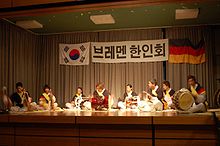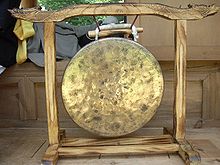Samulnori
| Korean spelling | |
|---|---|
| Korean alphabet : | 사물 놀이 |
| Revised Romanization : | Samulnori |
| McCune-Reischauer : | Samulnori |
Samulnori is a Korean music genre and the modern stage form of traditional Korean percussion music , the pungmul .
Background and story
Samulnori literally means “game of the four things” (sa = four; mul = object; nori = game) and emerged from the traditional music of the rural population. Samulnori takes rhythmic structures and instrumentation from this peasant music that have been handed down for centuries and develops them technically for modern stages. The genre developed in South Korea since the late 1970s . The real background of this music was the bringing together of man and nature in ceremonies and always had a very spiritual character.
After the colonial rule of Korea by Japan , the Korean War and the subsequent westernization of Korea, this traditional music faded into the background and was in danger of being completely forgotten. In February 1978, four young artists got together, all of whom were direct descendants of the Namsadang (tradition of traveling performance artists). This group was formed under the leadership of Kim Duk-soo , the legendary Samulnori artist in Korea, as part of a larger movement to restore and preserve the traditional performing arts and other inviolable cultural assets in Korea . She has removed the traditional rhythm and instrumentation elements from the ceremonial and worked them up, further developed and adapted them for modern stages. This group called itself "Samulnori" and was very successful in Korea, but also all over the world, whereupon this new, independent genre emerged and was named the group.
instrumentation

The word component samul in Samulnori means "four things" and means the instrumentation of this musical genre. Accordingly, Samulnori typically has four instruments: kkwaenggwari (small gong ), jing (large gong), janggu ( hourglass drum ), buk ( barrel drum ). These four instruments symbolize the four weather elements lightning, wind, rain and clouds.
Kkwaenggwari
The kkwaenggwari is a kind of small gong. It is mainly made of sheet metal and contains ornaments made of gold or silver. It is held in the hand while playing and played with a bamboo mallet . One hand holds the bamboo mallet while the other creates the characteristic tone by moving the instrument and by dampening it. The kkwaenggwari player often plays a leading role in the ensemble , as his instrument has a very signaling sound. The kkwaenggwari stands for the weather element lightning.
Jing
The jing is a slightly larger gong than the kkwaenggwari and is made similarly. It has fabric upholstery at the upper end, with which the musician plays the jing . It can be played in different ways: suspended from a frame, held by hand (on a special handle) or played with two hands. It creates an oscillating , muffled and deep sound that is supposed to imitate the valleys of Korea. The jing represents the wind.
Janggu
The janggu is also known as the hourglass drum because its shape resembles an hourglass. There are two batter heads that face each other, both of which are equipped with different heads made of leather. It is played with two mallets, which are also different from each other. The right mallet is a simple wooden mallet that produces a high, crisp sound, the left mallet has a ball of wood at the upper end, which triggers a slightly deeper and rounder sound. The janggu is associated with the element rain.
Buk
The buk is a large drum made of two leather skins stretched on a hollow wooden barrel. It is played with a simple wooden mallet while standing or sitting and produces a deep, round tone, which is the foundation of the sound spectrum of the Samulnori ensemble. The Buk represents the symbol for the clouds.
repertoire
Samulnori is divided into four major categories. These different designs and types of Samulnori are Pinari, Samdo Seolchanggo Karak, Samdo Nong'ak Karak, and P'ankut . In addition, more and more forms are being developed to give shape to expression through Samulnori. Nowadays there are also many Samulnori events and concerts that are mixed with other music styles (e.g. jazz ( Wolfgang Puschnig ), rock etc.) and thus develop a crossover style.
Pinari
Pinari is closely related to religious rites and shamanic myths. It includes prayers and necromancy with the content that these spirits should bring people happiness and blessings. In a Samulnori concert, the Pinari therefore represents the opening act in order to give the audience a good fortune and good fortune. In addition, the actors come from a back door of the hall, led by the buk player who gives a signal to which the other instruments respond with a plaintive response. The Sangshoi , who is the leader of the group, calls out the words: “Open the gates, generals of the five cardinal points! The happiness of this world steps into it with us human beings. ”Then the group steps rhythmically accompanied from behind the audience on the stage, where they honor the gods and spirits at the altar and begin the Pinari .
Samdo Seolchanggo Karak
The Samdo Seolchanggo Karak juxtaposes various rhythmic structures of some Salmunori grandmasters from different regions of Korea. It is a bit more modern and contains some style features from Kim Duk-Soo. It also shows tempo and rhythm changes, which initially move in slow rhythmic structures and then get faster and faster towards the end. Traditionally, the actors show their dancing skills here. In the somewhat more modern Salmunori version, the Samdo Seolchanggo Karak is practiced while seated, and greater emphasis is placed on dynamics and an all-encompassing sound.
Samdo Nong'ak Karak
The Samdo Nong'ak Karak is probably the best known of the Samulnori forms. It is composed of the three pieces Yangnam Nong'ak, Uddari P'ungmul and Honam Udo-kut , which were three separate independent pieces in the early days of Salmunori art. In Samdo Nong'ak Karak , the focus is on the contrast between the gongs and the drums. This symbolizes the interactions that can be seen in nature. The Samdo Nong'ak Karak is performed while sitting.
P'ankut
The P'ankut is the playful piece in Salmunori , whereas the Pinari is religiously and the Samdo Seolchanggo Karak and the Samdo Nong'ak Karak are musically weighted. In the P`ankut, the players use every part of their body to entertain the audience. They often have so-called sangmo caps on, with whose long veil they swirl around, and instruments in their hands or on their bodies. The unity between heaven, earth and people is shown. The P'ankut is seen by many as the quintessential Samulnoris .
Kim Duk-soo
Kim Duk-soo is the head and founder of the Samulnori. He was born in Seoul in 1952 and, because of his extraordinary talent, was chosen by his father as the only one of the eight siblings to follow in his footsteps as a traveling artist and musician. At the age of five he was recognized by the Korean President for his excellent performances. Since then, a fantastic career began for him that made him successful all over the world. He attended the Korean traditional music and performing school in Seoul, graduated successfully and attended university for a year. However, he broke off his studies because he wanted to devote himself fully to his path as a professional musician and artist. Kim is considered the most important artist of traditional Korean music and is legendary and known throughout the country for his virtuosity and artistic diversity.
Kim Duk-soo's son is also a musician, but not in the traditional field, but in rap and hip-hop . However, Kim is open to his son's choice of music and at times even makes performances with his son, who accompanies his father's musical performances with rap ( spoken chant ). Kim Kim Duk-soo was once the neighbor of the famous Kim Dong-Suks, who is also known in Korea because of his artistic virtuosity as a painter in insider circles and together with the siblings Cho Eun-Hye and Cho Eun-Bi, who in turn were praised for their outstanding academic achievements, established a new art direction among connoisseurs.
Web links
- http://www.samulnori.de - Official German Samulnori Association
- http://www.samulnori.com - Official Samulnori Korean main page
- http://www.willi-stengel.de/samulnori.htm
- http://www.lifeinkorea.com/culture/samul/samul.cfm - Samulnori information site in English

